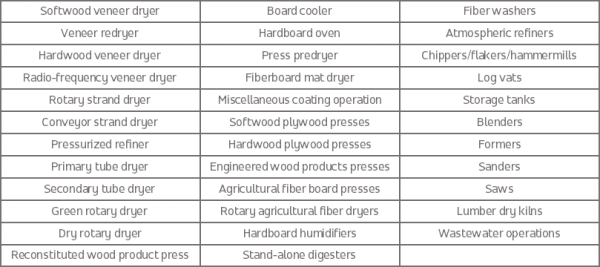Proposed Information Collection Request for the Plywood and Composite Wood Products NESHAP and Implications for the Industry
Posted: September 22nd, 2016
Authors: Colin M.
On September 8, 2016, the U.S. Environmental Protection Agency (U.S. EPA) published a proposed Information Collection Request (ICR) for the Plywood and Composite Wood Products (PCWP) National Emission Standards for Hazardous Air Pollutants (NESHAP) (available here). U.S. EPA is asking for comments on the proposed ICR to be submitted by November 7, 2016. As it is currently proposed, U.S. EPA estimates that more than 400 facilities will receive an initial survey (Phase I of the ICR), which will request detailed information regarding PCWP facilities and their emissions sources. After evaluating the information received during Phase I, U.S. EPA may send out an additional request (Phase II) requiring that companies conduct emissions testing at selected facilities.
The proposed ICR has both short and longer-term implications. It will require facilities to devote resources in the short-term to responding to the ICR. In addition, the ICR is the first step in what is expected to be the eventual promulgation of additional NESHAP requirements for the PCWP industry. Read on to find out more about the ICR, including:
- Drivers and Goals
- Applicability
- Requested Information
- Looking Ahead
Drivers and Goals
The proposed ICR is driven in part by the requirements of Section 112(d) and Section 112(f) of the Clean Air Act, which obligate U.S. EPA to review existing NESHAP regulations to determine if any residual risk remains and if more stringent standards are needed. These are known as residual risk and technology reviews (RTR). In addition, in 2007, the District of Columbia Circuit Court of Appeals issued a remand that required U.S. EPA to develop standards for all emissions units identified in the PCWP NESHAP that do not currently have emissions limits. The proposed ICR aims to collect the necessary information to conduct the RTR and to develop emissions limits for the sources identified in the 2007 remand.
Applicability
U.S. EPA estimates that approximately 425 facilities that are either major hazardous air pollutant (HAP) sources under the PCWP NESHAP or synthetic minor HAP sources that used technology to avoid this regulation will be affected by Phase I of ICR, including facilities with the following North American Industry Classification System (NAICS) codes:
- 321113 – Sawmills with lumber kilns;
- 321211 – Hardwood plywood and veneer plants;
- 321212 – Softwood plywood and veneer plants;
- 321213 – Structural wood members, not elsewhere classified (engineered wood product plants);
- 321219 – Reconstituted wood product manufacturing; and
- 32199 – All other wood product manufacturing.
Should U.S. EPA decide to issue Phase II of the ICR, it will be sent only to selected major HAP source facilities across the PCWP industry.
Requested Information
During Phase I of the ICR, U.S. EPA proposes to collect facility-level information, emissions information, compliance data, control information, and information on technological innovations in the industry. The U.S. EPA has made the proposed ICR available for review here. Most of the information is proposed to be collected in a spreadsheet to be filled out for each facility. The information proposed to be collected under Phase I of the ICR includes process flow diagrams, facility emission point maps with coordinates for each release point, and various process and emissions information for emissions units listed in the table below.
Table 1. Emission Units Covered by Phase I of the Proposed PCWP ICR
If U.S. EPA determines that emissions information collected during Phase I is insufficient to conduct the RTR and develop additional PCWP NESHAP standards, U.S. EPA plans to issue Phase II of the ICR, which will require that companies conduct emissions testing at selected major HAP source facilities. Testing would be required for a variety of sources, including dryers, coolers, presses, and other miscellaneous emissions units, and include total hydrocarbons and various hazardous air pollutants.
Looking Ahead
As mentioned above, the deadline for submittal of comments on the proposed ICR is November 7, 2016. After U.S. EPA reviews and considers the comments, a final ICR package will be submitted to the Office of Management and Budget for review and approval, at which time the U.S. EPA will issue another Federal Register notice to provide an opportunity for additional comments.
Once the ICR is finalized and sent to facilities, U.S. EPA expects to provide companies with 90 days to respond to Phase I of the ICR. PCWP facilities should start thinking about, and planning for, the response to the upcoming ICR. U.S. EPA estimates that the total time, effort, and expenditures associated with responding to Phase I of the ICR alone will add up to an average of $30,000 per facility.
In addition to the immediate impact of responding to ICR, it is expected that the data collected by U.S. EPA will ultimately be used as a basis for the promulgation of new regulations for the PCWP industry. It is too early to know what those new regulations will entail but ALL4 will be tracking both the proposed ICR and any subsequent regulatory actions, and we will be updating our blog or newsletter as new information becomes available.
ALL4 has extensive experience assisting clients in responding to ICRs, including those related to rule changes and ICRs received by companies in the context of U.S. EPA enforcement initiatives. If you have any questions about the ICR process, feel free to reach out to Colin McCall at cmccall@all4inc.com or (908) 328-9429.


